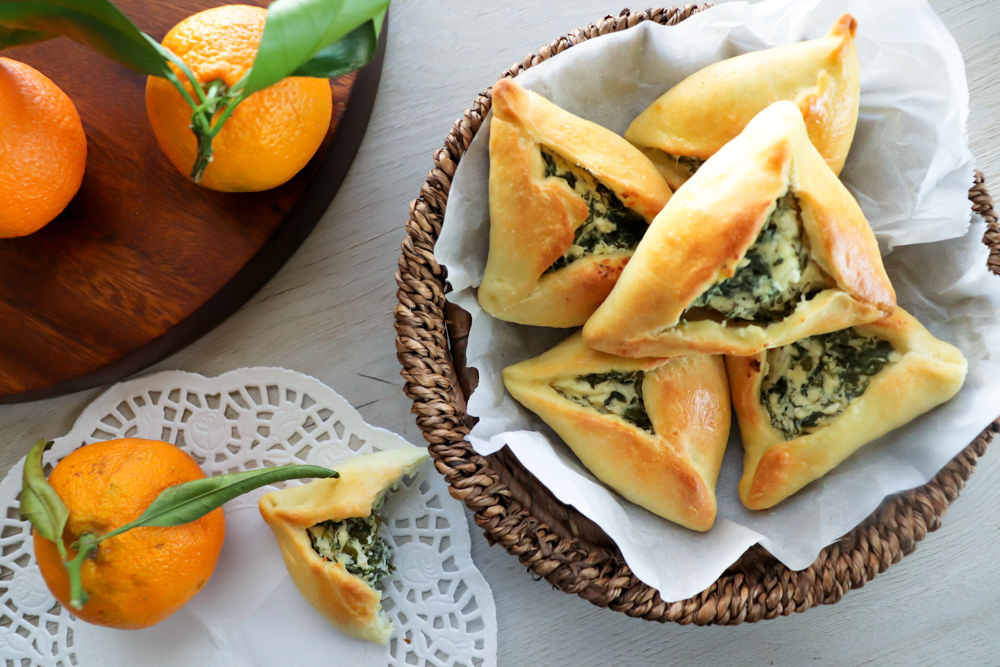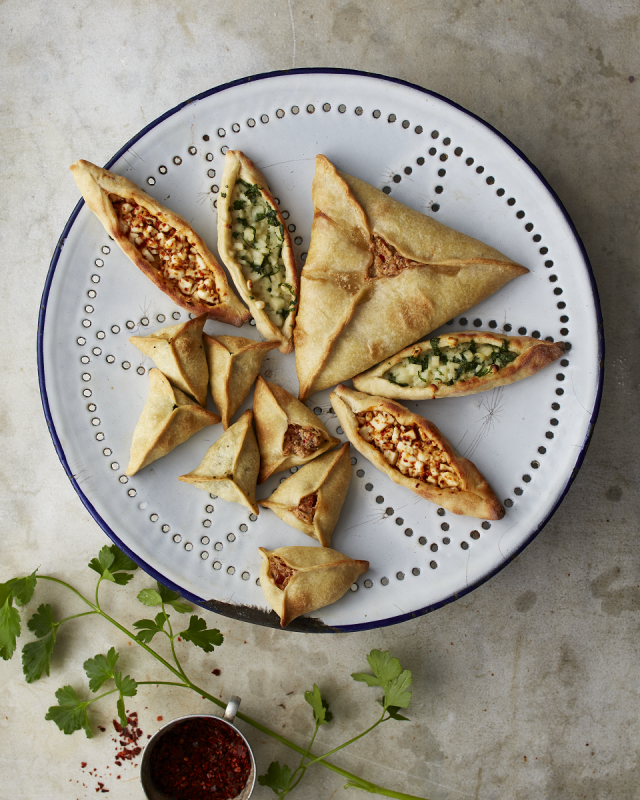The fatayer is one of the staples of Middle Eastern cuisine, found as far afield as Iraq, Egypt, Jordan and Palestine.
In Lebanon, they are made in triangles, large or small, with the pastry encasing the filling. Next door, in Syria, they are small and shaped like boats, with the pastry folded over only part of the filling to let some of it show in the middle.
Fatayers are a quintessential street food in both countries, sold from bakeries that make them throughout the morning; they are also served in restaurants as part of a mezze spread. Possibly they come into their own during the Ramadan iftar, when they are eagerly consumed at the breaking of the fast.

Home cooks in Lebanon and Syria also make trays of them, although many will only prepare the filling at home. This is then taken to the neighbourhood baker, who encases it in his own dough and bakes it to complete the fatayer.
Indeed, the dough is just as important as the filling. Lebanese fatayer are made with an unleavened dough enriched with olive oil, while the dough for Syrian fatayer is leavened and made slightly sweet with milk.
Fillings can include eggs, dairy produce (cheese or labneh) and green herbs and vegetables (spinach, purslane, Swiss chard and fresh thyme – the long-leaved one used in salads or pickles).
The recipe below offers two different styles of filling for Lebanese fatayer, as well as two sizes of triangles. Note that while the larger triangles will be quicker to assemble, the presentation will not be as dainty as for the smaller versions.
Recipe
Makes: 20 small or 4 large
Preparation time: 1-2 hours
Ingredients
Fatayer dough
- 160g (1¼ cups) unbleached all-purpose flour, plus more for shaping
- ¼ tsp fine sea salt
- 2 tbsps extra-virgin oil
- filling of choice (see below)
Spinach filling
- 1 small onion (100g/3½oz), very finely chopped
- sea salt
- ¼ tsp finely ground black pepper
- 1 tbsp ground sumac
- 200g (7 oz) spinach, thinly sliced
- 1 tbsp pine nuts
- juice of ½ lemon or to taste
- 1 tbsp extra-virgin olive oil
Labneh filling
- large onion (200g/7oz) very finely chopped
- ½ tsp ground cinnamon
- ½ tsp ground allspice
- ¼ tsp finely ground black pepper
- pinch of red pepper flakes (optional)
- sea salt
- 1 medium tomato (100g/3½ oz), finely diced
- 375g (1½ cups) strained yoghurt
- 1 tsp unsalted butter, at room temperature
Method
Spinach filling
- Combine the onion, a little salt, pepper and sumac in a bowl and mix with your fingers, rubbing the seasonings into the onion to soften it.
- Put the sliced spinach in a large bowl and sprinkle with a little salt. Rub the salt in with your hands until the spinach is wilted.
- Squeeze the spinach very dry. Transfer to a clean bowl and break up the clumps to separate the leaves as much as you can (obviously not one by one!)
- Add the seasoned onion to the spinach, together with the pine nuts, lemon juice and olive oil. Mix well. Taste and adjust the seasoning if necessary – the filling should be very tart to offset the rather bland dough
- Place the filling in a sieve to drain off the excess juices.
Labneh filling
- Place the onion, cinnamon, allspice, black pepper, pepper flakes (if using) and a little salt in a bowl. With your fingers, rub the seasonings into the onion to soften it.
- Add the tomato, yoghurt, and butter and mix well. Taste and adjust the seasoning if necessary.
Dough
- Mix the flour and salt in a bowl, then make a well in the centre.
- Add the oil to the well and, with the tip of your fingers, rub the oil into the flour.
- Gradually add 80ml water, bringing in the flour as you go. Mix until you have a rough dough.
- Transfer the dough to a lightly floured surface and knead for 3 minutes.
- Shape the dough into a ball, invert the bowl over the dough and let it rest for 15 minutes.
- Knead for 3 more minutes, or until the dough is smooth and elastic.
- Shape into a ball and cover with a damp kitchen towel.
- Let the dough sit on your counter while you prepare the filling.
Small triangles
- Preheat the oven to 230º C (450º F)
- Divide the dough in half, roll each half into a ball and flatten each slightly
- Dip one ball of dough into flour on both sides. Shake off the excess flour and roll out into a large thin round about 2mm (1/10 inch) thick, turning the dough over regularly
- Using a 7.5cm (3in) round pastry cutter, cut the sheet of dough into as many rounds as you can, minimising waste. Start from the edge and work your way around the outside before moving into the inside
- If you do not have pastry cutters, use a thin-rimmed glass
- Gather up the scraps, knead them together and let them rest
- Turn the rounds over. Place 1½ to 2 teaspoons of the filling of your choice in the centre of each round
To shape the triangles
- Lift two sides of a round of dough, about one-third of the round on each side. With your thumb and index finger, pinch the edges together, halfway down, making a thin raised joint.
- Lift the open side of the dough and pinch it equally to both loose ends in order to form a triangle. It should completely encase the filling and have a thin raised inverted “Y” in the middle.
- Make sure you pinch the dough tightly together so that it does not open during baking.
- Transfer the filled pastries to a non-stick baking sheet (or a regular baking sheet lined with parchment paper or a silicone baking mat) and continue until you have used up all the dough and filling. You should end up with about 20 pieces.
- Bake for about 10 minutes, or until golden. Serve hot, warm, or at room temperature.
Large triangles
- Instead of 20 small triangles, you can also make 4 large triangles
- Divide the dough into 4 pieces and roll each into a ball
- Flatten each ball of dough into a large round.
- Follow the same instructions for making the small triangles, using one-quarter of the filling for each triangle
Anissa Helou is a chef, food writer, journalist, broadcaster, consultant and blogger with a focus on the cuisines and culinary heritage of the Middle East, Mediterranean and North Africa. Her most recent book Feast: The Food of the Islamic World won the James Beard award in the international category in 2019. You can follow Anissa on her Instagram and website. All photos by Kristin Perers








